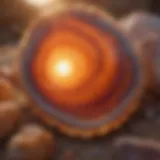Unveiling Oregon's Diverse Rock Formations: A Geological Exploration
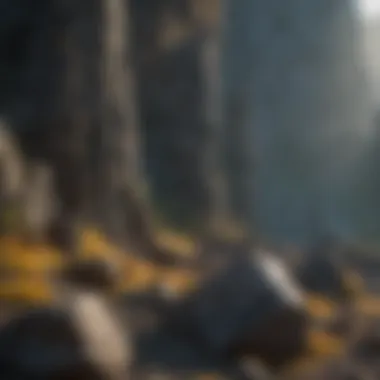

Rock and Fossil Identification
Types of Rocks and Fossils
Oregon's geological landscape is a treasure trove of diverse rock formations and fossil specimens. Volcanic rocks, such as basalt and obsidian, are prevalent in the region due to its volcanic history. Sedimentary rocks like sandstone and shale also form significant portions of Oregon's geological makeup, showcasing the intricate layers of the Earth's history embedded within them. Fossil enthusiasts can unearth marine fossils, plant imprints, and even petrified wood, each holding clues to Oregon's ancient ecological past.
Characteristics to Look For
When identifying rocks and fossils in Oregon, several key characteristics can aid enthusiasts in distinguishing between different types. Texture, color, hardness, and structure are pivotal in classification. For rocks, examining mineral composition and crystal formations can provide substantial insights. Fossil collectors often focus on detailing such as bone structure, imprint patterns, and composition to determine the origins and age of the specimens.
Tools for Identification
To facilitate accurate rock and fossil identification, collectors in Oregon can utilize various tools. Magnifying glasses and microscopes enable close inspection of intricate details on specimens. Geology hammers and chisels assist in retrieving samples for further examination. Field guides and geological maps offer valuable information on the distinct rock formations and fossil locations across Oregon's diverse terrain.
Introduction
In the realm of geological wonders, Oregon stands out as a trove of diverse rock formations waiting to be explored and understood. This article serves as a comprehensive guide to the myriad types of rocks that shape Oregon's fascinating landscape. By delving into the geological makeup of this region, rock and fossil enthusiasts will uncover a wealth of information that sheds light on the intricate processes that have sculpted Oregon over centuries.
One of the key elements that make the exploration of rocks in Oregon so compelling is the sheer variety of formations present in the state's terrain. From towering volcanic peaks to tranquil riverbeds lined with sedimentary layers, Oregon offers a mosaic of rock types that paint a vivid picture of its geological history. By understanding these different rock categories – volcanic, sedimentary, and metamorphic – enthusiasts can grasp the intricate tapestry that forms the bedrock of Oregon's diverse landscapes.
Moreover, this exploration goes beyond mere identification of rock types; it offers a gateway to understanding the dynamic forces that have shaped Oregon's terrain. Through a lens of geological curiosity, readers will gain insights into the processes of rock formation, erosion, and transformation that have played out across Oregon's expanse. By unraveling the mysteries of these rocks, one can appreciate the deep connections between geology and landscape evolution, highlighting the profound impact that rocks have on shaping the natural world.
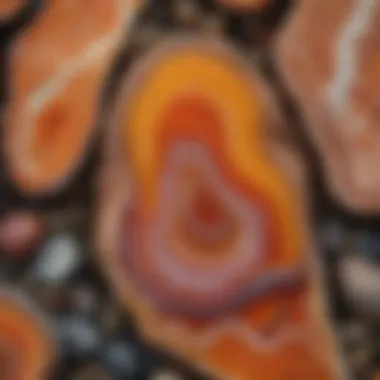

This introduction sets the stage for an immersive journey into the geological marvels of Oregon, inviting readers to embark on a discovery of rocks that hold the secrets of the state's captivating landscapes. By illuminating the importance of understanding rock formations, this article aims to engage readers in a thought-provoking exploration that showcases the beauty and complexity of Oregon's geological heritage.
Geological Overview of Oregon
A profound understanding of the Geological Overview of Oregon serves as the foundation for unraveling the diverse types of rocks that grace the state's landscape. The geological landscape of Oregon is a fascinating tapestry of volcanic, sedimentary, and metamorphic rocks, each with its unique characteristics and formation processes. This section delves into the significance of comprehending the geological overview, highlighting the various rock types that have shaped Oregon's terrain over millions of years.
Volcanic Rocks
Basalt
Basalt, a primary component of Oregon's volcanic rock formations, plays a pivotal role in the geological makeup of the state. Recognized for its fine-grained texture and dark coloration, Basalt is highly abundant in regions such as the Columbia River Basalt Group. Its rapid cooling process results in distinctive columnar formations, making it a prominent feature in Oregon's geological composition. Basalt's durability and resistance to weathering make it an ideal choice for studying the state's volcanic history, showcasing its efficacy in retaining historical geological information and providing insights into Oregon's volcanic past.
Andesite
Andesite, another prevalent volcanic rock in Oregon, contributes significantly to the region's geological diversity. Characterized by its intermediate composition between Basalt and Rhyolite, Andesite exhibits a unique blend of characteristics that make it a valuable inclusion in this exploration. Its moderate silica content and magma viscosity influence its eruptive behavior, leading to the formation of diverse landforms. Through understanding the properties and formation processes of Andesite, researchers gain a deeper perspective on Oregon's volcanic activities and the impact of different lava compositions on the landscape.
Rhyolite
Rhyolite, a silicic volcanic rock abundant in Oregon, offers a rich source of information on the state's geological evolution. With its high silica content and light coloration, Rhyolite stands out among the volcanic rocks found in the region. The explosive nature of Rhyolitic eruptions shapes distinctive volcanic landforms, such as obsidian flows and volcanic domes, adding to Oregon's unique geological tapestry. By examining the characteristics and formation processes of Rhyolite, geologists can unravel the intricate narratives of Oregon's volcanic history, shedding light on past geological events and trends in the region's landscape evolution.
Unique Rock Formations in Oregon
Smith Rock State Park
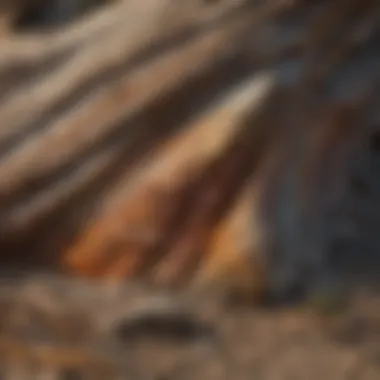

Smith Rock State Park stands as a revered gem in Oregon's geological profile. Spanning over 650 acres, this park boasts a mesmerizing array of rock formations, including sheer cliffs, rugged pinnacles, and challenging rock faces that lure rock climbers and hikers from around the globe. The significance of Smith Rock State Park lies in its role as a prime destination for rock climbing enthusiasts, offering a playground of diverse volcanic rocks and intriguing geological formations. Visitors can witness the power of geological forces at play through the intricate designs etched into the rocks over millennia, making it a quintessential site to explore Oregon's geological heritage.
Painted Hills
The Painted Hills, located in the John Day Fossil Beds National Monument, showcase a kaleidoscope of colors that mesmerize and intrigue visitors. These hills, composed of layers of volcanic ash and clay minerals, create a vibrant canvas of reds, golds, and blacks that change hues with the shifting light. The uniqueness of Painted Hills lies not only in their picturesque beauty but also in the geological story they unveil. Each hue represents a distinct geological era, offering a glimpse into the dynamic natural processes that shaped Oregon's landscape over millions of years.
Oregon Coastline Rocks
The Oregon coastline is adorned with a diverse assortment of rocks that narrate a tale of ancient marine environments and geological transformations. From towering sea stacks to intricate tide pool formations, the rocks along the Oregon coast mesmerize visitors with their striking shapes and textures. These coastline rocks provide a window into Oregon's geological past, elucidating the forces of erosion, sedimentation, and tectonic activity that have sculpted the coastline into its current form. Exploring the Oregon coastline rocks unveils a rich tapestry of geological history waiting to be deciphered and appreciated by rock enthusiasts and nature lovers alike.
Fossilized Discoveries
In the meticulous exploration of the diverse rocks of Oregon, the section on Fossilized Discoveries takes center stage as a critical component of understanding the geological history of the region. Delving into the preserved remnants of ancient life forms, fossilized discoveries offer a window into the past, allowing us to unravel the mysteries of prehistoric ecosystems that once thrived in Oregon. By examining these fossils, we can glean valuable insights into the evolution of the landscape and its inhabitants over millions of years.
Fossilized discoveries bring invaluable contributions to this article by bridging the gap between geology and paleontology, providing a holistic view of Oregon's geological and biological history. The meticulous study of fossils not only enriches our understanding of ancient organisms but also aids in reconstructing past environments, enabling us to piece together the intricate puzzle of Oregon's geological past. Their significance lies in offering a tangible connection to the distant past, unlocking a trove of knowledge that enhances our grasp of the rich natural heritage of Oregon.
Fossil Beds National Monument
The Fossil Beds National Monument stands as a testament to the ancient history ingrained in Oregon's rocks, encapsulating a wealth of fossilized treasures that date back millions of years. Nestled within this protected area are layers of sedimentary rock teeming with well-preserved fossils, offering a glimpse into the diverse array of flora and fauna that once inhabited this region. Through meticulous excavation and study, researchers have unearthed a plethora of fossilized remains, ranging from plant specimens to intricate animal fossils, each contributing to the vibrant tapestry of Oregon's geological heritage.
John Day Fossil Beds
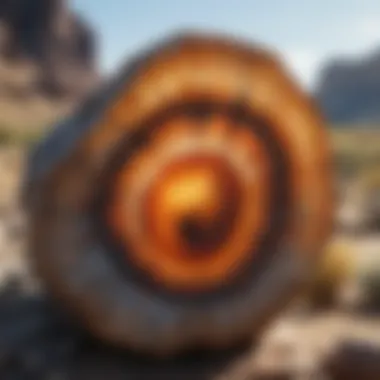

Among the notable sites within Oregon that showcase the wonders of fossilized discoveries, the John Day Fossil Beds stand out as a beacon of paleontological significance. This fossil-rich region encapsulates a chronicle of ancient ecosystems, with layers of sedimentary rock harboring a myriad of exceptionally preserved fossils. The John Day Fossil Beds serve as a time capsule, preserving a snapshot of Oregon's ancient past and providing researchers with a treasure trove of information to decipher the evolutionary history of the region. Through meticulous excavation and analysis, these fossil beds unveil the secrets of bygone eras, offering a compelling narrative of Oregon's geological evolution.
Impact of Geology on Oregon's Landscapes
When delving into the diverse types of rocks in Oregon, understanding the impact of geology on the state's landscapes is crucial. The geological makeup of Oregon plays a significant role in shaping its terrain, flora, and even climate. By comprehending the intricate relationship between geology and landscapes, we gain a deeper appreciation for the natural wonders that abound in this region.
Geological Significance
Oregon's landscapes bear the imprints of millions of years of geological processes. The volcanic rocks, sedimentary formations, and metamorphic sequences that grace the terrain tell a tale of the Earth's evolution. For instance, the iconic basalt formations such as the Columbia River Basalts have not only influenced the state's topography but have also created unique habitats for flora and fauna.
Environmental Impact
Moreover, the impact of geology goes beyond aesthetics. The soil composition, influenced by underlying rock types, determines the fertility and suitability of land for agriculture. In Oregon, regions with different rock formations exhibit varying soil qualities, affecting the types of crops that can thrive in specific areas. Understanding these geological nuances is essential for sustainable land management and ecological preservation.
Geological Hazards
Additionally, Oregon's diverse geology presents both opportunities and challenges. The state is susceptible to geological hazards such as landslides, earthquakes, and volcanic eruptions. By studying the geological origins of these risks, scientists and policymakers can better predict and mitigate potential disasters, safeguarding both the environment and human settlements.
Cultural and Recreational Aspects
Furthermore, the impact of geology extends to cultural and recreational realms. Oregon's unique rock formations and landscapes attract tourists, rock climbers, and outdoor enthusiasts from around the world. These geological wonders not only contribute to the state's economy but also foster a sense of connection to the natural world, inspiring conservation efforts and environmental stewardship.
Conclusion
One of the key elements emphasized in the Conclusion is the importance of understanding the geological composition of Oregon, not just for academic purposes but also for appreciating the natural beauty and complexity of the state's rock formations. By synthesizing the information presented throughout the article, the Conclusion aims to leave readers with a profound appreciation for the intricacies of Oregon's geological past and present.
Furthermore, the Conclusion section delves into the benefits of exploring the diverse rock types in Oregon, shedding light on how studying these formations can provide insights into the state's evolution over time. It encourages rock and fossil enthusiasts to delve deeper into the rich tapestry of Oregon's landscapes, fostering a sense of curiosity and appreciation for the geological wonders that abound in the state.
In essence, the Conclusion section of this article serves as a reflection of the diverse and captivating journey through Oregon's rocks, encapsulating the core themes of exploration, appreciation, and preservation that define the study of geology in this unique and enchanting state.
